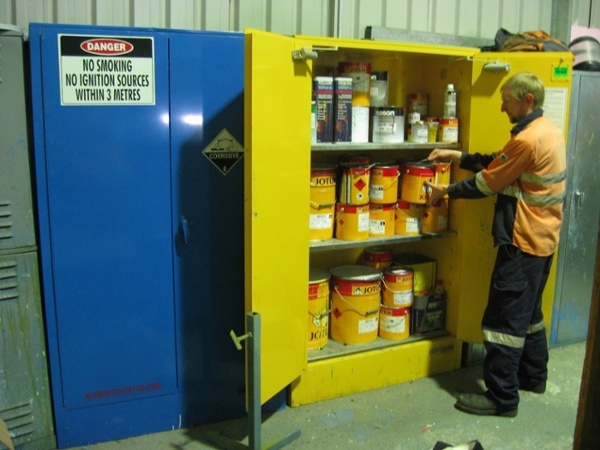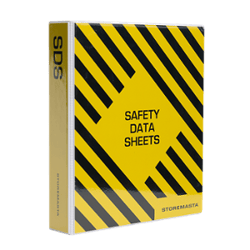This article focuses on four key areas of chemical safety in the workplace. It will help you meet your obligations under WHS legislation in Australia, as well as guide your overall approach to hazardous substance safety at your workplace. Let’s get started.
1. Understand The Chemicals You Are Using
The first and most critical aspect of using hazardous substances and dangerous goods safely is to understand exactly what you are dealing with. To do this you’ll need the safety data sheet (SDS) for each and every hazardous substance that you have onsite. Your chemical supplier or chemical manufacturer must provide you with a current safety data sheet, with updates to the safety data sheets required every 5 years. Your SDS may also be available via an SDS management program, such as Chemwatch.
Whenever you start using a new chemical at your workplace, it’s a good practice to obtain the SDS from the supplier before it arrives onsit e. This gives you time to review the chemical hazards and make any necessary changes to work design.
This may include things like buying new protective clothing for workers or installing a new gas cylinder storage cage.
From the safety data sheets, you’ll learn the properties of the chemical — as well as the risks and hazards associated with its use.
You should study the safety data sheet carefully because chemicals often have more than one hazard class. This means that the hazardous substance could be toxic as well as combustible.
Refer to the safety data sheet of each product onsite to determine the properties and hazards associated with that chemical prior to it arriving onsite.
When you know exactly what you are dealing with, including all the chemical properties and hazards associated with the product, you can:
- Design the physical areas of the workplace to safely accommodate the chemical
- Develop safe operating procedures and work methods
- Store chemicals safely, away from anything that might cause a reaction
- Label the chemical with correct dangerous goods signage
- Buy the protective equipment and safety clothes you need
And once you know the full extent of the risks and hazards to using a hazardous chemical, you might even decide to just use something else — and substitute a chemical that is a whole lot safer.
REMEMBER: Only use the safety data sheet prepared by the manufacturer or importer of the hazardous substance. Do not rely on generic or third-party safety data sheets.
2. Provide The Correct PPE
Once you understand the dangerous properties of a chemical, you can buy the necessary PPE.
PPE is personal protective equipment which prevents the chemical contacting a worker’s eyes, skin, airways, or even their whole body.

Purchasing the correct PPE is essential for staff safety when working with or handling hazardous substances, such as paint and other flammable liquids.
The safety data sheets will specify any PPE required for:
- Personal hygiene (washing hands, coveralls, aprons)
- Skin protection (chemical resistant gloves, rubber boots)
- Eye protection (eye guards, goggles)
- Respiratory protection (air supplied hoods, face masks)
- Thermal protection (flame resistant body suit)
In addition to this, the SDS will also provide details on the requirement for safety showers, eyewash stations or specialised first aid equipment that must be available at the workstation.
REMEMBER: PPE should always be considered as a last resort for controlling any risk, so it’s best to find ways for workers not to contact the chemical at all.
3. Store Chemicals Safely
Many chemicals react violently when put in contact with other substances. This may cause a vast range of chemical hazards including fires, explosions or toxic gas clouds.
To avoid issues with incompatible substances, you must ensure that any hazardous chemicals used at your worksite are stored safely — and in a way that complies with Australian Standards and WHS legislation.
Like to learn more about chemical segregation?
To learn more about the requirements for safe chemical storage, start with the safety data sheet. It will have a section that details how the chemical should be stored as well as any incompatible substances that should be kept separate.
Some general tips for all workplaces include:
- Store chemicals away from food preparation and service areas
- Keep chemicals secured so they cannot be accessed by unauthorised staff or contractors
- Clearly label each chemical with the correct placard and warning sign
- Make sure the storage area is well ventilated and away from work activities that might cause heat or sparks
- Use a dedicated safety cabinet, manufactured in full conformance with the relevant Australian Standard
- Make sure portable containers of cleaning chemicals are secured when not being used
- Ensure that all chemical containers are compatible with the hazardous substances being stored
REMEMBER: You should also refer to the WHS Regulation in your state and make sure you meet all the requirements for the handling and storage of Dangerous Goods.
4. Train Staff Thoroughly
When hazardous chemicals are used at a workplace, it’s not enough to just provide staff with PPE and safety clothes. Every staff member who is at risk of being harmed by a chemical must understand the risks and hazards and how they personally could be impacted. This includes office and administration staff who may need to wear personal protective equipment when visiting manufacturing areas of the worksite. It also includes training staff and contractors so they know how to respond to an emergency situation such as an explosion, major spill or fire.

Training your staff, supervisors and contractors is vital for ensuring chemical safety at your workplace.
New staff and contractors should undergo a thorough safety induction before commencing any duties, as well as receive ongoing job specific training.
Staff and contractors should clearly understand:
- The risks and hazards of a chemical that might affect their safety
- Fire and chemical emergency training, including evacuation procedures
- What to do if they are accidentally exposed to a chemical (safety shower, first aid)
- How to respond to a co-worker who has been exposed (stay safe, buddy system, first aid, notify emergency services)
- How to safely handle a chemical (dispensing methods, cleaning storage areas, disposing of containers, earthing containers and maintenance equipment)
- How to correctly store a chemical (what containers to use, labeling and signage, who is authorised to access chemical stores, work activities prohibited in the immediate area)
REMEMBER: If there is a risk of chemical exposure to temporary visitors at your worksite, limit their access to operational areas. You should also consider what training they may need if contacting work areas is unavoidable.
Chemical Safety in the Workplace
This article has introduced some key elements of risk management when using hazardous chemicals in the workplace. But if you’re serious about getting it right — making your workplace safer and complying with the WHS legislation in your state — we encourage you to download our free eBook. How To Manage the Risk Of Hazardous Chemicals In The Workplace is an easy to read guide that contains the action plan and templates you need to you meet your WHS obligations. It’s the next step in chemical safety and can be accessed by clicking on the image below.
Joining the team as a Dangerous Goods Storage Consultant, Melissa Hampton became Storemasta's Marketing Manager in late 2021. With extensive knowledge and experience in chemical compliance, Melissa is responsible for leading the Marketing team and helping shape their marketing strategy. In her spare time, you can find Melissa hiking, swimming and enjoying the great outdoors in beautiful north-west Tasmania.

